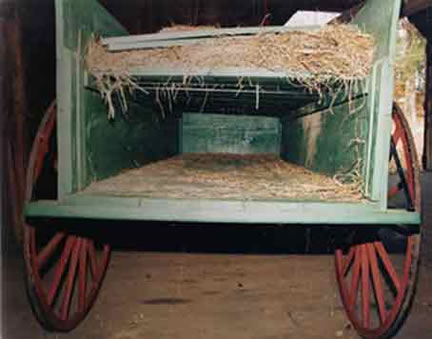Historic wagon of Historic Jamestown Society, Jamestown, NC, Used to transport runaway slaves to Ohio, Levi Coffin and Quakers active in Underground Railroad
From the Mendenhall Homeplace.
“This wagon has been preserved through the interest and good offices of five successive generations in the Centre community, three of which lived in the same “Stanley Homeplace.” The wagon has now come to the Historic Jamestown Society as a gift from Joshua Edgar Murrow, deceased in 1980, and his wife, Hazel Richardson Murrow, and their three children, Joshua Edgar Murrow, Jr., of Lawndale, N. C; Mary Murrow Hamilton of Atlanta, Ga., and Gertrude Murrow Sillman of Greensboro, N. C.
If the wagon could talk, it would tell of many exciting and sometimes perilous events. Not the least of these stories would be the ones telling of several trips to Ohio with a load of runaway slaves. The “trains” crossed into free territory at Wheeling, West Virginia, and continued on to a Friend’s home in Ohio. The drivers were two young men, selected because they were eager for adventure and because no one would be likely to suspect such young men of “slave-running.” The two youths were Andrew Murrow (1820-1908) and Isaac Stanley (1832-1927), who grew up in the home of their foster parents, Joshua and Abigail Stanley, after they had been orphaned. Actually Isaac was a nephew of Joshua Stanley. Andrew Murrow was the grandfather of Joshua Edgar Murrow (1892-1980) who reveled in hearing his grandfather tell of these dangerous and exciting journeys to Ohio.
This historic wagon came to the Historic Jamestown Society through the good offices of Stacey and Ruth Hockett of Pleasant Garden, close and lifelong friends of Joshua Edgar Murrow, Sr., who had received it as a much valued gift from Abigail Stanley Hodgin, daughter of Isaac Stanley Edgar fully intended to re-build the aging vehicle but never got around to it. He gave special instructions to the Hocketts to care for it, and it was from their barn that the wagon finally came to us.
Cecil E. Haworth was instrumental in obtaining the Wagon for the Historic Jamestown Society. The above information was taken from the brochure “Precious Cargo” written by him. The rest of the brochure may be read below:
There is probably only one vehicle left in North Carolina that was used to transport runaway slaves in the days before the Civil War. That vehicle is now the property of the Historic Jamestown Society and is on display at the Mendenhall Homeplace located on West Main Street in Jamestown, North Carolina, opposite the High Point City Lake Park. There is a second wagon, almost identical, in the Levi Coffin House and Museum located in Fountain City, Indiana, on U.S. 27.
The story of the North Carolina wagon is a fascinating one, because it is part of the story of the Underground Railroad.
The Underground Railroad was a system for helping black slaves to escape to the northern states and to Canada. It was called “underground” because fleeing slaves who seemed to mysteriously disappear from sight were in fact hiding in the homes of people who were opposed to slavery.
The Underground Railroad was active in the years before the Civil War, especially from 1830 to 1860. Possibly as many as 50,000 slaves in the South were helped to escape to free territory beyond the Ohio River and often on into Canada.
Assisting runaway slaves was against the law and so it was done with as much secrecy as possible and no records of any kind were kept for fear they might serve as incriminating evidence. A new vocabulary was developed to conceal operations and protect individuals. Cooperating homes in the network were called “stations,” the vehicles were called “trains,” the drivers were known as “conductors,” the fugitives were referred to as “baggage” or “cargo.” The movement of “passengers” was mostly at night; they traveled in small groups numbering from two or three to seldom more than a dozen. Movement was slow. The “stations” were ten to twenty miles apart and transportation was mainly by horseback, in carriages or wagons, and often on foot.
Fugitive slave laws provided severe penalties of stiff fines and imprisonment. (See Fugitive Slave Law of 1797.) To interfere with the recovery of an owner’s slaves was considered a serious crime. But many Quakers and some members of other religious groups preferred to live by the words of the Bible: “Thou shalt not deliver unto his master the servant which is escaped from his master unto thee.” (Deuteronomy 23:15) To these abolitionists and others, the laws of God superseded the laws of man.
Levi and Catherine Coffin
In North Carolina, one of the leaders in giving assistance to fugitive slaves was Levi Coffin, Jr. (1798-1877). Levi was born at New Garden, now Guilford College. As a boy he saw numerous occasions when slaves were badly abused.’ He resolved that when he grew up he was going to do something about these matters. As he grew through the adolescent years he became acquainted with a young Quaker girl, Catherine White of Randolph County, who shared his convictions regarding slavery. They were married in 1824. During their courtship and early years of marriage they felt ever more strongly that the Lord was calling them to some special service on behalf of the slaves but they were still unclear in their minds as to where and just how they could help. However, since both sets of parents and their brothers and sisters had now moved to Indiana along with many other relatives and friends, they felt that their futures lay there. Early in the autumn of 1826, they, with their year-old son, packed all their household belongings on a wagon and headed for the West.”
Read more:
http://www.mendenhallhomeplace.com/wagon.html



